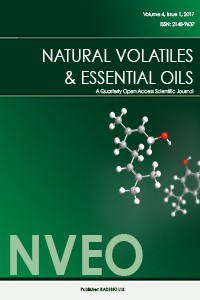Öz
Kaynakça
- Mozaina, K., Cantrell, C.L., Mims, A.B., Lax, A.R., Tellez, M.R., Osbrink, W.L.A., 2008. Activity of 1,4- Benzoquinones Against Formosan Subterranean Termites (Coptotermes formosanus), J. Agric. Food Chem., 56, 4021–4026.
- Eisner, T., Jones, T.H., Hicks, K., Silberglied, R.E., Meinwald, J., 1977. Quinones and phenols in the defensive secretions of neotropical opilionids, J. Chem. Ecol., 3(3), 321 329.
- Gulaboski, R., Bogeski, I., Mirceski, V., Saul, S., Pasieka, B., Haeri, H.H., Stefova, M., Staneva, J.P., Mitrev, S., Hoth, M., Kappl, R., 2013. Hydroxylated derivatives of dimethoxy-1,4-benzoquinone as redox switchable earth-alkaline metal ligands and radical scavengers. Scientific Reports, 3, 1865, Doi: 10.1038/srep01865.
- Gunbilig, D., Boland, W., 2009. Defensive Agents of Blaps femoralis, a Traditional Mongolian Medicinal Insect, Sci Pharm., 77, 597–604.
Öz
The substrate of this study, 2,5-dimethyl-1,4-benzoquinone (DMBQ), is one of the naturally occurring quinones which is found in
insects as a defence metabolite. In the present study, DMBQ was biotransformed by using the micro-fungus Corynespora cassicola.
The transformation metabolite was initially screened by TLC and GC-MS, then further characterized by NMR (13C- and 1H-NMR)
spectroscopic techniques and was identified as ‘2,5-dimethyl 1,4-benzenediol’. In addition, both the substrate and metabolite was
evaluated for the in vitro anticandidal, and antioxidant properties along with XTT-cytotoxicity.
Anahtar Kelimeler
Benzoquinone microbial biotransformation biological activity
Kaynakça
- Mozaina, K., Cantrell, C.L., Mims, A.B., Lax, A.R., Tellez, M.R., Osbrink, W.L.A., 2008. Activity of 1,4- Benzoquinones Against Formosan Subterranean Termites (Coptotermes formosanus), J. Agric. Food Chem., 56, 4021–4026.
- Eisner, T., Jones, T.H., Hicks, K., Silberglied, R.E., Meinwald, J., 1977. Quinones and phenols in the defensive secretions of neotropical opilionids, J. Chem. Ecol., 3(3), 321 329.
- Gulaboski, R., Bogeski, I., Mirceski, V., Saul, S., Pasieka, B., Haeri, H.H., Stefova, M., Staneva, J.P., Mitrev, S., Hoth, M., Kappl, R., 2013. Hydroxylated derivatives of dimethoxy-1,4-benzoquinone as redox switchable earth-alkaline metal ligands and radical scavengers. Scientific Reports, 3, 1865, Doi: 10.1038/srep01865.
- Gunbilig, D., Boland, W., 2009. Defensive Agents of Blaps femoralis, a Traditional Mongolian Medicinal Insect, Sci Pharm., 77, 597–604.
Ayrıntılar
| Birincil Dil | İngilizce |
|---|---|
| Konular | Sağlık Kurumları Yönetimi |
| Bölüm | Articles |
| Yazarlar | |
| Yayımlanma Tarihi | 5 Mart 2017 |
| Yayımlandığı Sayı | Yıl 2017 Cilt: 4 Sayı: 1 |

